
From Idea to Success: Crafting a Business Plan That Works
Why should we create a business plan in the first place? Just think about the impacts of starting a business with no plan at all. You might've got the answer to the question, isn't it? A business that starts without a plan has no chance for long-term success. This is why it's essential.
A business plan is a comprehensive document that serves as a guide to start and grow a business. It can be a roadmap that contains a business’s goals, objectives, and the necessary strategies that a company should follow to achieve them.
It includes resource requirements for achieving the goals and objectives of a business, which helps make informed decisions. Moreover, it provides insights to potential investors and stakeholders to understand what value proposition the company has and the potential market opportunity.
Key Takeaways
- Understand the importance of a business plan for ensuring long-term success and guiding business growth through clear goals and strategies.
- Learn how a well-crafted business plan supports quick decision-making, attracts investors, identifies risks, and keeps the business on track toward its objectives.
- Explore the critical steps of defining your product or service, identifying your target market, and analyzing the competitive landscape to ensure a strong foundation for your business.
- Discover the importance of developing a solid business strategy, including setting goals, creating a pricing strategy, and crafting a comprehensive sales and marketing plan.
- Recognize the value of accurate financial projections and regular financial data analysis for securing investments, planning resources, and ensuring the financial health of your business.

Importance of A Well-Crafted Plan
Startups need a well-crafted plan for several reasons. The plan should contain all the necessary details to support business growth and attract potential investors. Let's figure out some reasons:
- Provides Necessary Information: A business plan provides important and complete information for a business to make quick and efficient decisions. A well-crafted business plan supports the company in successfully achieving its business goals and vision. It also drives the business in the right direction and ensures that it is directed toward its goals.
- Attract Potential Investors: A company's investment plan isn't comprehensive without a business plan. This means that a well-crafted plan is crucial to attract potential investors to the company. If a business firm doesn't prepare a plan, it will be tough for it to secure potential investments from investors.
- Assist in Identifying Risks and Challenges: Identifying major risks and challenges is a vital aspect for businesses to successfully manage potential risks. An early identification of risks can help mitigate them with proper controls. Therefore, creating a well-crafted business plan is vital for an organization to build a successful business.
Understanding the Business Idea
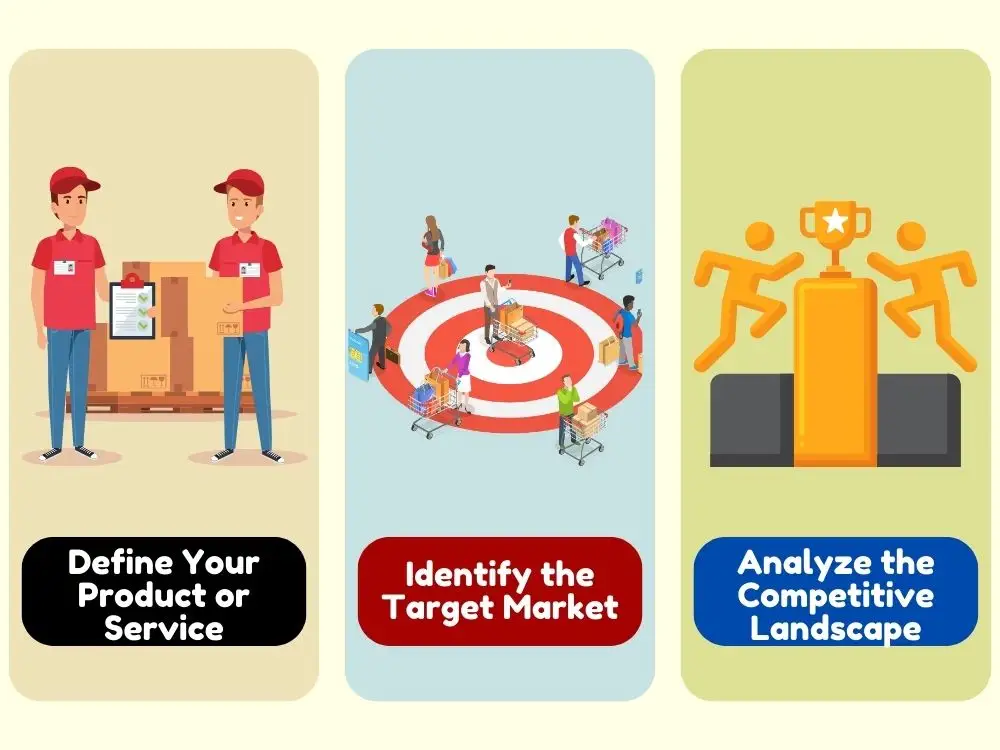
Defining the Product or Service
The first step in understanding the business idea is defining the product or service. This helps understand what a company can offer to its customers, what makes it different from its competitors, and what value the company can deliver to the target market.
Also, it's essential to perform thorough market research to find out the customers’ requirements. This is essential to match the product or service delivery according to the customer's needs. Defining the product or service also includes pricing, packaging, and proper delivery methods. This ensures that the product or service is the right choice with the correct price, right packaging, and fast delivery.
Identifying the Target Market
This is one of the most important things a company should consider. This helps discover the market requirements of different customer groups from different geolocations. By identifying the right audience or customers, companies can do proper marketing with the right and targeted advertisements.
It also helps build a strong relationship with target customers. Identifying the target market is useful to acquire customers and do promotional stuff. This helps the company stand out from the competitors.
Analyzing the Competitive Landscape
Analyzing competitiveness is crucial for every business organization. It's helpful to find out who the competitors are and the types of products and services they offer to their customers. This helps businesses to strategically approach decision-making. For example, the analysis provides data to set optimum pricing, packaging, delivery, product quality, and any other factors to beat the competitors.
It also helps identify market gaps and drive the company to the customers successfully. Regular analysis of the competitive landscape is good for anticipating and preparing for necessary changes in the market and consequently succeeding in the long term.
Developing the Business Strategy
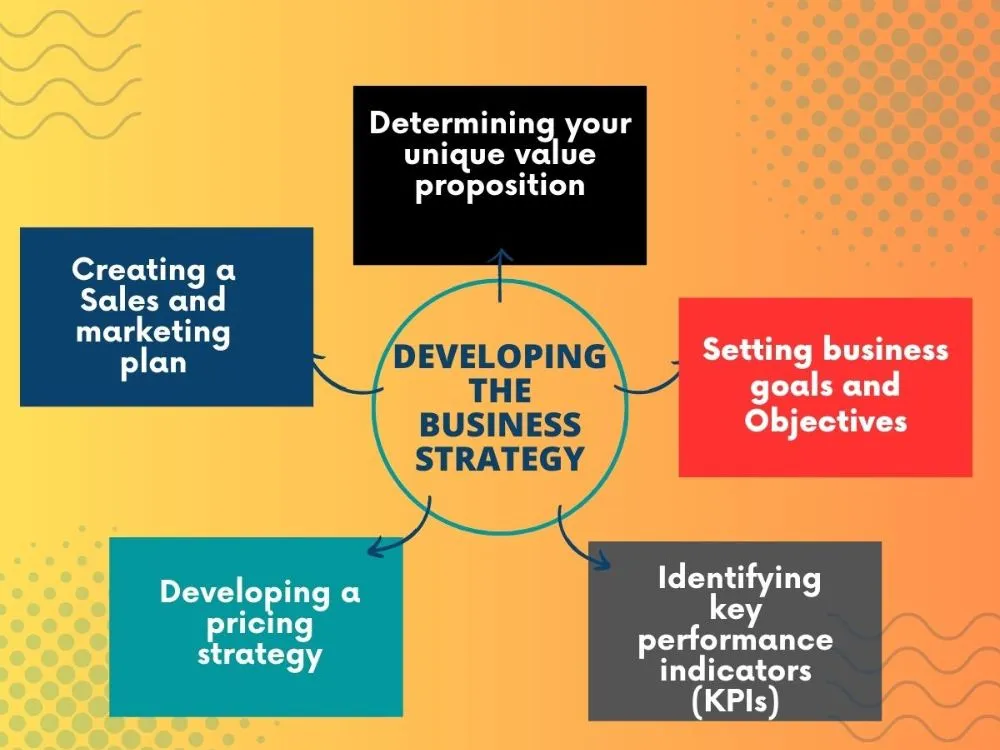
Determining a Unique Value Proposition
A unique value proposition (UVP) sets a business apart from competitors. It clearly states what unique benefits or solutions a company offers customers compared to alternatives. An effective UVP helps customers understand why they should choose your products or services. It must provide compelling reasons that demonstrate clear value and advantages over competitors.
A strong UVP strengthens market position and builds brand loyalty. It should be concise and impactful, highlighting distinctive capabilities that competitors cannot match. When well-crafted, it guides customer decisions and establishes long-term relationships.
Setting Business Goals and Objectives
Setting clear business goals and objectives is crucial for driving organizational success. They enable leaders to track employee progress and measure achievements against intended outcomes. They also serve as performance metrics that help identify gaps and areas for improvement.
To set efficient goals and objectives, it's vital to consider the business’s mission, vision, strengths, and weaknesses. A proper setup will ensure business success in the long term.
Identifying Key Performance Indicators (KPIs)
Key performance indicators (KPIs) are quantifiable performance-measuring tools that are helpful to measure the objectives of a business effectively. Organizations can measure their objectives using these KPIs to ensure long-term success.
When companies choose KPIs to measure their performance, it's essential to find data or metrics that are vital to the business. It's also important to monitor the KPIs to process optimization, prioritize needs, and make quick decisions that help achieve goals.
Developing a Pricing Strategy
A pricing strategy is a foundational step to the business's success. It helps determine the appropriate price for a product or service. It also aids in maximizing the profits of an organization, beating the competition, and retaining customers.
Companies must consider essential factors like manufacturing cost, competitors' prices, customer demands, market patterns, and fluctuations when setting a price for the product or service.
Creating a Sales and Marketing Plan
A well-crafted sales and marketing plan helps generate leads and close more sales deals. This is important to increase the business revenue. Companies follow various sales and marketing strategies to ensure consistent sales growth.
Utilizing the best possible strategies, such as social media marketing (SMM), email marketing, SEO, and paid advertisements, helps achieve business goals towards improving sales and revenue. A complete sales and marketing plan helps companies stay competitive and focused.
Organizing Your Business Structure
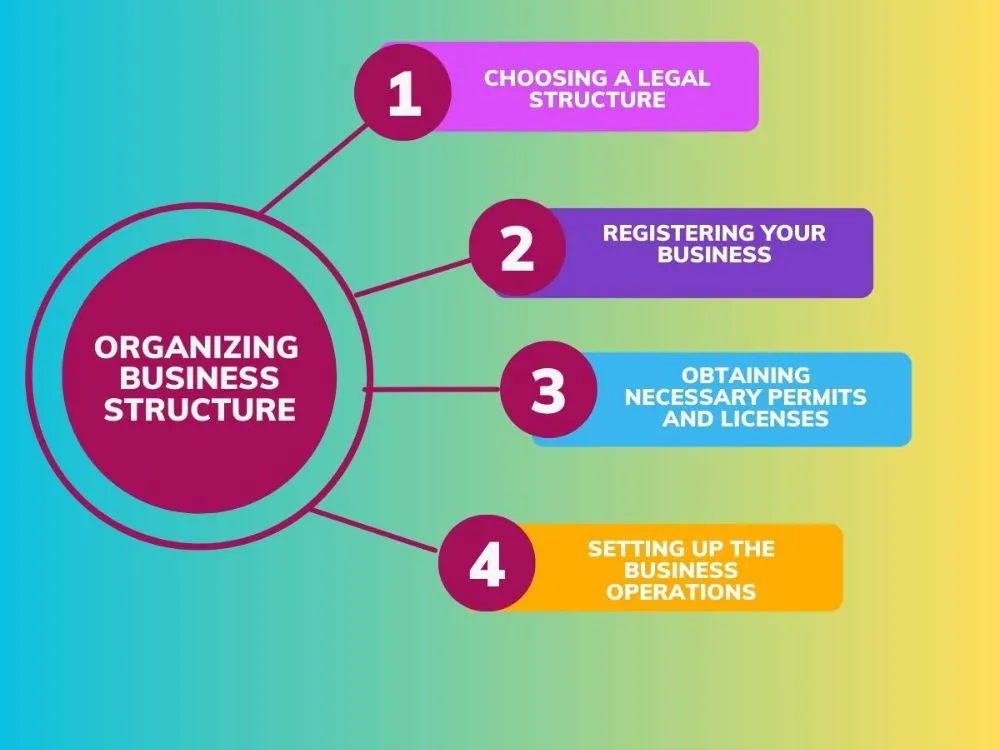
Choosing a Legal Structure
It's essential to choose the correct legal structure for the business to organize everything. You can choose from different structures like sole proprietorship, limited liability company (LLC), partnership, or corporation.
Every structure has its benefits and drawbacks. Therefore, the business owner must weigh up the advantages and disadvantages of these structures to choose the relevant option for their business.
Registering Your Business
After choosing the correct legal structure for the business, the next step is registering. As per the business legal requirements, registering the business may vary for every legal structure. There are certain documents required to be submitted for business registration.
By registering the business, it becomes a legal entity where the business owner/owners get several benefits from it. For example, business registration offers a unique identity where no one can use your business name because of the trademark.
Also, tax calculation and handling will be easy for registered businesses. Plus, the customers' trust will be high. This is because the customers research the company before making purchases. Ultimately, it helps grow the business in the long run.
Obtaining Necessary Permits and Licenses
The importance of obtaining permits and licenses may vary based on the business location and industry. Some common permits and licenses, like business licenses and tax registration, are obtained from legal entities. It's very important to research all permits and their requirements before jumpstarting the business operation.
If a business owner fails to obtain these necessary permits and licenses, it will result in legal consequences and delays. Therefore, taking all necessary permits and licenses is important before starting the business.
Setting Up Your Business Operations
After obtaining all necessary permits and licenses, a proper business setup is inevitable. It involves creating all necessary arrangements for business operations. It also includes setting up the business goals, policies, mission statement, and a proper organizational structure.
The organizational structure should be a clear document that defines the roles and responsibilities of each employee. It's also vital to evaluate the availability of financial resources to identify how much additional funding is required to maintain the business operation. Therefore, taking the time to set up the business operation can reduce certain risks and support the company's growth.
Creating Financial Projections
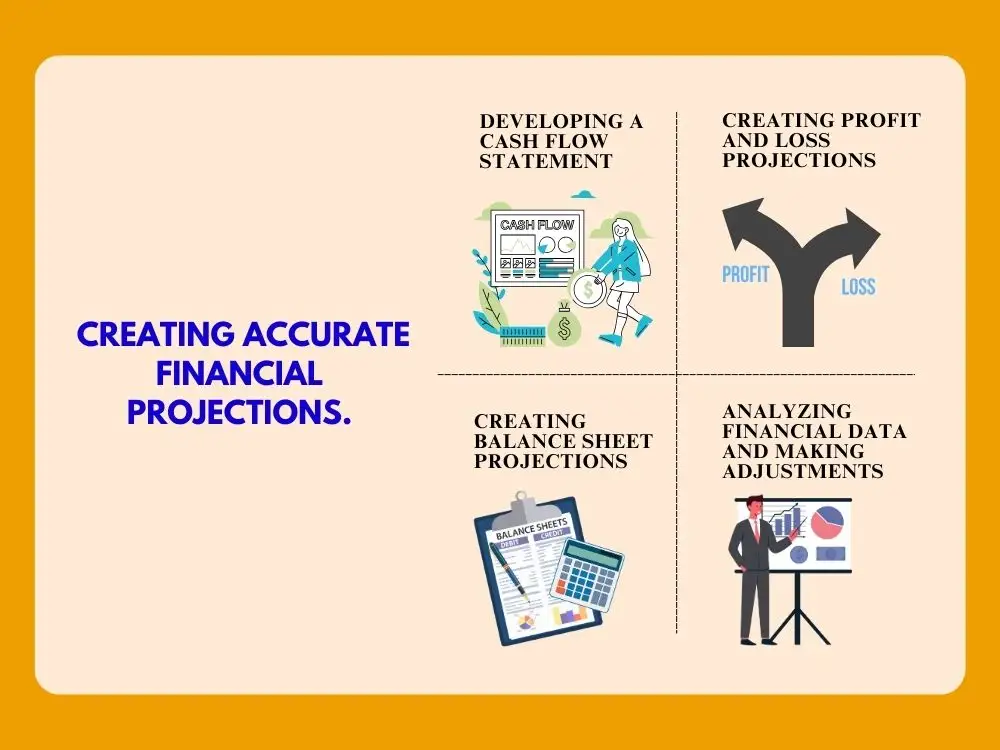
Developing a Cash Flow Statement
Creating a financial projection is a crucial step in developing a business plan. One of the key aspects of financial planning is developing a cash flow statement. This statement clearly shows the cash inflows and outflows of a business in a certain period.
It also helps find out cash shortages and fill them with proper cash planning. Further, identifying cash surpluses helps utilize the surplus for potential investments. A cash flow statement is a powerful tool that assists businesses in securing their finance and attracting investors.
Creating Profit and Loss Projections
Profit and loss projections help estimate the business revenue and expenses in a specific period. It's one of the efficient tools for creating financial projections that assist in making financial decisions and determining which areas need improvement.
It consists of all sales revenue, outwards, inwards, classification of expenses, and so on. Conducting thorough research is necessary to prepare profit and loss projections. When it is done correctly, it will make a huge impact on businesses and their financial growth.
Creating Balance Sheet Projections
A balance sheet lists the company’s equity, liabilities, and physical assets. It can be an invaluable tool in making financial decisions and clearly shows the financial status of an organization. By properly creating a balance sheet, businesses can able to identify their current and long-term liabilities.
Plus, the current and fixed assets and their depreciation values are properly calculated when preparing the balance sheet. Similarly, the annual profit or loss is added or subtracted from the equity part of a balance sheet. A balance sheet is an overview that helps make informed financial decisions.
Analyzing Financial Data and Making Adjustments
Analyzing the data and making necessary adjustments include examining past financial statements like income statements, balance sheets, and cash flow statements. This helps identify the trends in finances in the past.
It's necessary to analyze this data to make financial adjustments that help boost the income and financial stability of a company. Also, analyzing data helps discover possible factors such as inflation, interest rates, and other critical market factors that affect the financial statements in the past.
It also helps identify the best possible ways to reduce the impacts on revenues, assets, and cash flows in the future. It's not a one-time process where analyzing financial data requires regular revisions and updates.
Crafting Your Business Plan

Structuring Your Business Plan
This is one of the essential steps that provide a clear picture of an organization’s vision, mission, strategies, and resource requirements. A business plan should be complete and required to contain all necessary sections and information.
A well-structured business plan provides information to the investors and other stakeholders to better understand the company. An organization should focus on structuring the business plan in a way that it can interpret the business function and goals.
Writing An Executive Summary
It's crucial to write an executive summary for a business plan, including all necessary details of the company, mission statement, the types of products or services, market, financial projections, and plans.
It can be an overview for the readers to understand the organization’s detailed business plan. Plus, readers can decide whether to continue reading the entire document or not, based on the quality of the executive summary. It summarizes all the key points in a business plan and provides easy understanding for the readers.
Detailing the Business Strategy
A well-crafted business plan should contain a detailed business strategy. It should outline the essential strategies that the company needs to follow, such as pricing strategy, marketing strategy, resource acquisitions, competitors' handling, and many more.
It includes tactics to reach potential customers and increase market share and overall growth. Clearly defining the business strategy helps identify challenges and opportunities and drives businesses towards achieving their goals. A detailed business strategy ensures the business's success by putting the company on the right track to match the needs.
Including Financial Projections
Crafting your business plan involves outlining the financial projections of a company that aims to achieve over time. This entails analyzing detailed sales and expense forecasts for each product or service line, as well as examining overall market trends and competitive factors.
Proper financial projections enable the company to determine the necessary capital for its growth, identify efficient resource allocation, and make informed decisions. Integrating these projections into the business plan empowers entrepreneurs to confidently navigate their businesses toward sustainable and profitable growth.
Finalizing the Business Plan
This involves reviewing the document carefully and finding any mistakes or drawbacks. It's so important to review the business plan to finalize it because reviewing helps remove errors and improve the overall quality of the business plan.
Also, it's advisable to seek help from industry professionals and experts to get feedback on the specific business plan review to establish relevancy. Once the business plan is finalized then it can serve as an invaluable tool with a lot of advantages.
Pitching Your Business Plan
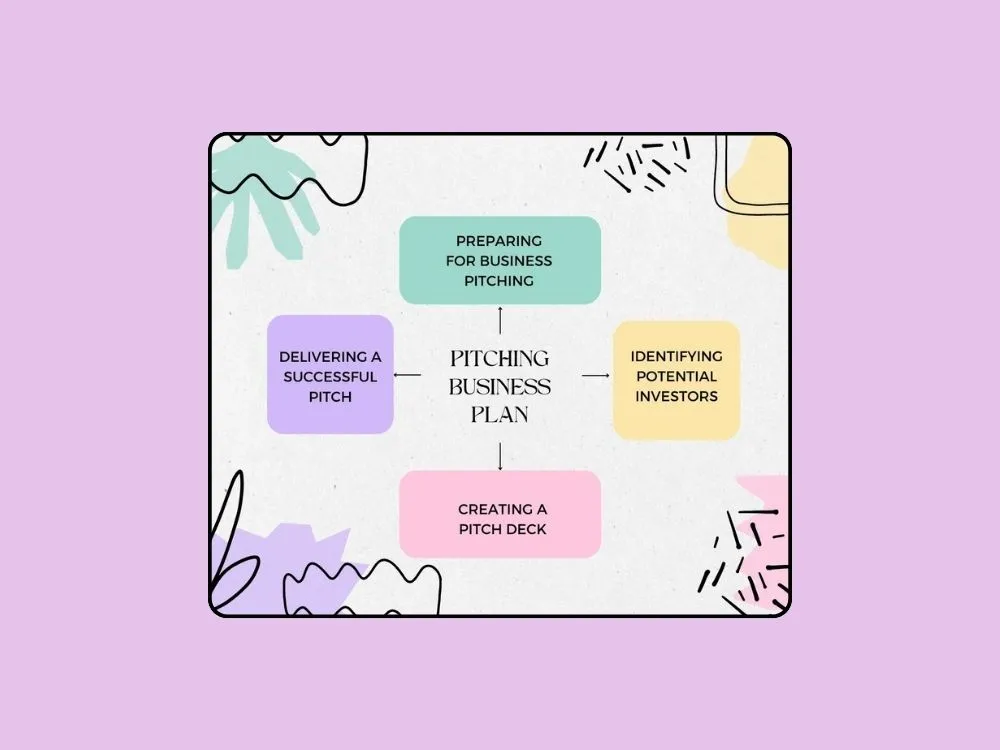
Preparing for Business Pitching
This is important for presenting the document of business ideas effectively. Plus, it guarantees funding or support from investors. First, thoroughly research the target audience, their needs, and market trends to tailor the pitch accordingly. Next, clearly express a unique value proposition and highlight how the product or service solves a problem or fulfills a demand.
Structure the business pitch with a captivating introduction, a brief overview of the business model, and a detailed financial projection. Predict potential questions or objections and craft concise and persuasive answers.
Practice the pitch repeatedly to refine your delivery, ensuring clarity, confidence, and impact. A well-prepared business plan pitch can be the key to attracting investors and stakeholders to support your entrepreneurial journey.
Identifying Potential Investors
When it comes to pitching your business plan, identifying potential investors is a paramount step in securing funding and support. Starting from a thorough market research to find investors who have a record of investing in businesses similar to yours, or who have shown interest in your industry.
Utilize diverse resources such as online platforms, industry events, and networking opportunities to extend your reach. Consider seeking out investors or strategic partners who align with the business goals.
Craft a compelling elevator pitch that emphasizes the unique elements of your business and resonates with potential investors. Tailor the pitch to address their distinguishing interests and showcase how their investment can contribute to the growth of the business.
Creating a Pitch Deck
A well-designed and effective pitch deck can communicate the business idea and generate interest from investors. Starting from outlining the essential segments of the pitch deck, such as a compelling title slide, a brief problem statement, and a clear solution that indicates the market potential.
Highlighting unique value propositions, competitive advantage, and market traction to showcase the business's viability. Include visuals such as charts, graphs, and similar images to explain data and projections clearly and engagingly.
Include details about the team, their expertise, and relevant achievements to build trust. Keep the content straightforward, focusing on the most essential details, and maintain a consistent visual theme throughout. A well-crafted pitch deck should capture attention by telling a compelling story and leaving a lasting impression.
Delivering a Successful Pitch
A successful pitch for your business plan requires careful preparation and adequate communication. Start by defining the business idea, target market, and competitive advantage. Crafting a clear report that grabs the attention of the audience from the beginning and using visuals, such as slides or prototypes, to enhance the presentation and make it more interesting.
Structure the pitch with a good introduction, a concise outline of the business model, a demonstration of market viability, and a persuasive call to action. Focus on the benefits and value of the product or service to the customers. Practicing the pitch multiple times helps refine the delivery and ensure clarity. Also, saving the pitch document in a PDF format helps to easily transfer the file from one device to another.
Wrapping Up
The primary goal of a business plan is to function as a roadmap in a business journey. A well-crafted plan is essential as it demonstrates professionalism, commitment, and understanding of the business idea. It also helps clarify business goals, identify challenges, and pursue growth opportunities.
Understanding the business idea is basic, as it will allow you to convey a unique value proposition and distinguish the business in the market. Developing a complete business strategy assures a clear path and guides the decision-making process. Organizing the business structure specifies the roles, responsibilities, and operational framework necessary for success.
With a well-crafted business plan, businesses are equipped with a powerful tool to steer the challenges and take the opportunities that come their way.
FAQs
Q1: How can I write a business plan?
To write a business plan, you should follow these steps:
- Outline the business plan's purpose, importance, and structure.
- Define your business idea, target market, and competitive landscape.
- Develop a clear business strategy, financial projections, and organizational structure.
- Review and finalize the plan, which ensures it's well-structured and tailored to your business needs.
- Be prepared to pitch it to potential investors or stakeholders.
Q2: What are the 5 reasons for a business plan?
Five key reasons for having a business plan are:
- Guiding your business
- Aiding in decision-making
- Attracting investors
- Mitigating risks
- Ensuring long-term success
Q3: Why is it crucial to regularly analyze financial data in a business plan?
By regularly analyzing financial data, businesses can easily adapt to changing circumstances. It helps in identifying trends, challenges, and opportunities. Monitoring factors like inflation, interest rates, and market fluctuations can ensure that you can make informed decisions and adjustments to maintain financial stability and growth in the future.
Explore Related Posts
https://smarttoolsai.com/post/risk-management-plan-for-your-high-risk-business
https://smarttoolsai.com/post/the-strategic-advantage-how-outsourcing-can-benefit-your-business
.webp)